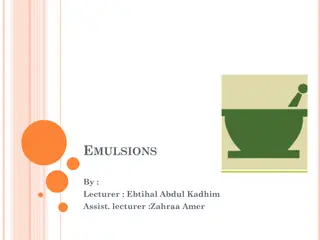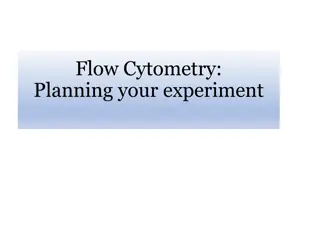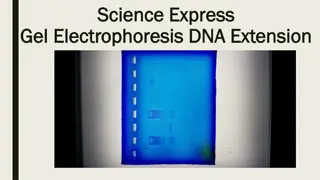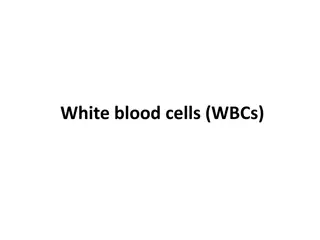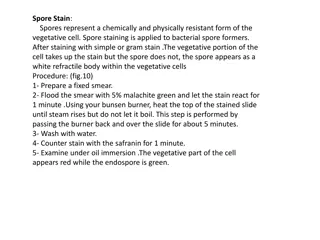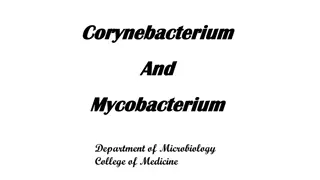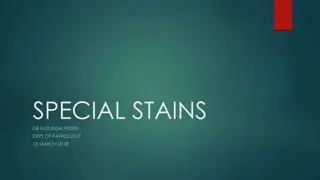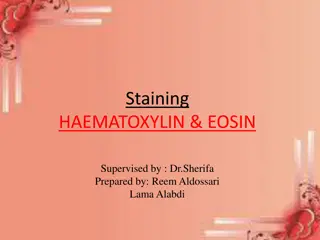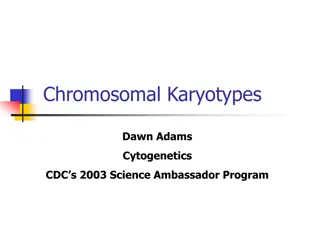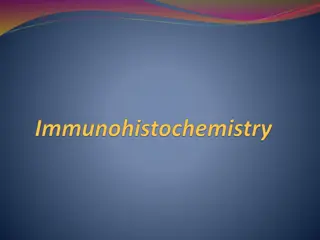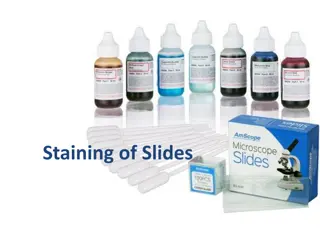Principles of Staining in Histopathologic Techniques
Beginning with an introduction to staining in biochemical techniques, this chapter delves into the types of stains, factors influencing selectivity, and commonly used stains in histopathology. Learning objectives include defining staining, discussing dye-tissue affinity, understanding selectivity factors, and classifying hematoxylin based on mordants. The content explores methods for protein demonstration, carbohydrate staining, and special stains. An overview of staining principles involving alcohol solutions and clearing agents is provided, along with insights on dye-tissue affinity and the two-way procedure involved.
Download Presentation

Please find below an Image/Link to download the presentation.
The content on the website is provided AS IS for your information and personal use only. It may not be sold, licensed, or shared on other websites without obtaining consent from the author.If you encounter any issues during the download, it is possible that the publisher has removed the file from their server.
You are allowed to download the files provided on this website for personal or commercial use, subject to the condition that they are used lawfully. All files are the property of their respective owners.
The content on the website is provided AS IS for your information and personal use only. It may not be sold, licensed, or shared on other websites without obtaining consent from the author.
E N D
Presentation Transcript
CHAPTER THREE Principles of staining
Content Introduction Types of stain Affinity of staining Factors that determine selectivity of stain Types of commonly used stains in histopathologic techniques
Learning objectives Upon completion of this chapter, the student will be able to: Define staining. Discuss factors that contribute to dye-tissue affinity. Explain factors affecting selectivity of stain. Explain the classification of hematoxyline on the basis of mordant used.
Learning object Describe method of demonstration of proteins. Describe carbohydrate stain. Describe special stain.
3.1 Introduction Staining is a biochemical technique of adding a classic specific dye to a substrate: DNA Proteins Lipids and Carbohydrates to qualify or quantify the presence of a specific compound.
3.2 Types of stain Negative stain is the type of stain that does not color the tissue or cells but surrounds the tissue as a result uncolored tissue can be seen against a background color.
Types of stain Supravital staining is the stain taken by living cells. Special stain is the stain that identifies various specialized structures. Differential stain the stain uses two or more dyes that react differently.
Principle of staining The stained slide must go through the reverse process that it went through from paraffin section to water . The stained slide is taken through a series of alcohol solutions to remove the water, then through clearing agents to a point at which a permanent resinous substance beneath the glass cover slip, or a plastic film, can be placed over the section.
3.3 Affinity of staining Affinity means the force, which binds the dye to the tissues. The word crisp is used in textile industry instead of affinity. Affinity is not a one-way procedure but a two-way procedure as it depends on the tissue as well as on the dye.
3.3.1 Factors contributing to dye-tissue affinity Factors that can adversely affects staining of tissues: Solvent-solvent interaction (Hydrophobic bonding) Reagent-reagent interaction Reagent-tissue interaction (Vander -Waal forces) Columbic attraction Hydrogen bonding Covalent bonding.
3.3.1.1 Solvent-solvent interaction There is a tendency of hydrophobic grouping or chemicals or substances to come together even though initially dispersed in aqueous (water) solution. The water molecules are transiently held together in clusters by hydrogen bonding.
Solvent-solvent interaction These clusters are stabilized by hydrophobic group Any process that involves breakup of the clusters in to disorganized water molecules will tend to occur spontaneously. Phenylalanine and tryptophane side chains or biphenyl naphthol are hydrophobic grouping.
3.3.1.2 Reagent-reagent interaction Dye interacts with each other and form aggregates. Dye aggregation increases with concentration. Cations or basic dyes build up in tissues where there is high negative charge such as, - polysaccharides in mast cell granules and - cartilage matrix.
Reagent-reagent Metachromatic staining This is due to dye aggregation having spectral properties unlike those of monomeric dyes. Silver impregnation technique There is stain-stain interaction. Gomer s type enzyme histochemistry There is stain-stain interaction
3.3.1.3 Dye - tissue interaction or Vander- Walls reaction Van-deer-Walls force acts between dye and tissues. is of short range. Therefore, Van-deer-Walls force is strong where close reagent contact is possible.
Van-deer-Walls force. Substrates and chemicals that favor Van-der-walls bonding include: Tyrosine and tryptophane residues of proteins; Heterocyclic bases of nucleoproteins; Halogenated dyes such as, - rose Bengal, - phloxine, - enzyme substrate, - naphthyl indoxyl system.
3.3.1.4 Columbic attraction Columbic attraction termed as salt link or electrostatic bond. the electrostatic bonds arise from electrostatic attraction of dissimilar ions is the most widely acknowledged reagent tissue interaction. Example The colored cation of basic dyes and tissue rich in anion such as - phosphated DNA and RNA - carboxylated or - sulphated mucosubstances. structures
Columbic attraction.. In case of columbic attraction, the amount of dye able to enter a given tissue will depend on: charge of dye, magnitude of charges, amount of non-electrolyte present in dye bath ability of tissue to sink or swell.
3.3.1.5 Hydrogen bonding Hydrogen bonding(H-bonding) is a localized bond when a hydrogen atom lies b/n two electronegative atoms such as ,H or N . It will rarely be an important source of reagent- tissue affinity when aqueous solvents are used. if dye is taken by other process, H- bonding may subsequently contribute to affinity.
3.4 Factors that determine selectivity ofstain Dye or stains are not taken by every part of tissue, and this is called selectivity of stain. Factors that determine selectivity of stain include: Number and affinity of binding sites Rates of reagent uptake Rate of reaction Rate of reagent loss.
3.4.1 Number and affinity of binding sites The staining affinity of dye depends on: the number of binding sites of the dye to tissue. Reagent-tissue affinities and the number of binding site vary. Example non-ionic Sudan dye will have affinity for fat droplets, but none for the surrounding hydrated proteins. Therefore Sudan stains intensely fat tissues and not proteins or carbohydrates.
5.4.2 Rate of reagent uptake by the tissue Selectivity of the stain by the tissue depends on the rate of reagent uptake by the tissue. Therefore, selectivity can be controlled by modifying the time of staining.
Rate of reagent uptake by the tissue Example short period of staining mucin-staining method using Alcian blue or colloidal iron. prolonged period of staining nucleic acid and RNA-rich cytoplasm are also stained using Alcian blue or colloidal iron.
Rate of reagent uptake There are methods where three or more dyes diffuse at varying rates, as a result different structures can be stained by different dyes. Example collagen fibers stain rapidly while the muscle fibers stain at intermediate rate
3.4.3 Rate of reaction Selectivity of the stain also depends on the rate of reaction. This is because, - reactive stain yield colored derivatives, & - amount of color depend on the selective rates of reaction. Example The periodic acid oxidation step of the periodic acid- Schiff procedure, if sufficiently prolonged, oxidize various chemical structures present in tissue.
Rate of reaction Enzyme examples of reaction rates that affect selectivity. histochemistry provides many other Example at low pH the hydrolysis of an organic phosphate applied to a tissue section in a suitable incubation media will be rapid in those parts of the tissue containing acid phosphates. However, in structures containing alkaline phosphatase , the hydrolysis rate will be very slow.
3.4.4 Rate of reagent loss Some decolorized structures are not decolorized readily. tissues or structures while are other stained tissues and or readily
Rate of reagent loss. Differentiation Is when a decolorized tissue takes up the counter stain. Example staining of muscle striation with iron Haematoxyline and myelin sheath with Luxol Fast Blue. In regressive staining all structures are first stained quite non-selectively some times penetration aid such as heat or phenol. with the assistance of Subsequently, the tissues are extracted in a solvent. The solvent extracts the dye from the tissue. And this is known as destaining.
Rate of reagent loss. The staining conditions chosen to maximize selective affinity. Basic dyes must be applied from neutral or acidic solution. the concentration of inorganic salt present in a dye bath ,called critical electrolyte concentration. rate of reagent uptake, or subsequent reaction or loss of reagent or product.
3.5 Types of commonly used stains in histopathologic techniques 3.5.1 Haematoxyline (H) is the most popular & widely used histologic stain. extracted from heartwood Haematoxyline campechium with hot water. of the tree called can demonstrate clearly enormous number of d/t tissue structures.
Natural oxidation of Haematoxyline natural oxidation(ripening) is exposing haematoxyline to light & air and converting it to hematin. is a slow process, it may takes 3-4 months. the hematine solution retains its staining ability for a long time. Examples -Ehrlichs haematoxyline -Delafield s haematoxyline.
Haematoxyline.. Haematoxyline processed by various methods. also stains tissues that are In the routine H & E stain, nuclei stain blue-black with good intra nuclear details. While Eosin stains cytoplasm and connective tissue in varying intensity of pink, orange & red.
Haematoxyline.. Haematoxyline has many more uses than in E & H combination. Haematoxyline haematin, an oxidant product of Haematoxyline is a stain & a natural dye. by itself is not stain but
Production of haematin from Haematoxyline Haematoxyline is extracted from heartwood or logwood. It is precipitated by using urea. Haematin is produced from Haematoxyline by two ways. 1. Natural oxidation or ripening of Haematoxyline. 2. Chemical oxidation of Haematoxyline.
Chemical oxidation of haematoxyline haematoxyline is oxidized by chemicals such as - sodium iodate & - Mercuric oxide. Sodium is used as an oxidant in preparation of Mayer s haematoxyline Mercuric oxide for Harris haematoxyline
Chemical oxidation Advantages Oxidize haematoxylin almost instantaneously; Ready to be used after immediate preparation. Disadvantage have shorter useful life when compared to naturally ripened haematoxylin.
3.5.2. Classification of haematoxyline based on mordant used Classification of haematoxyline based on mordant: Alum haematoxylin; Iron haematoxylin; Tungsten haematoxylin; Molybdenum haematoxylin; Lead haematoxylin; Haematoxylin with out mordant.
3. 5.2.1 Alum haematoxylin Types of Alum haematoxylin Ehrlichs haematoxylin; Delafield s haematoxylin; Mayer s haematoxylin; Harris haematoxyline; Coles haematoxylin; Carazzi s haematoxylin.
Alum haematoxylin. Blueing After staining with haematoxylin, the section is treated with:- tap water or - Scott s tap water or - lithium carbonate. The red color of the nuclei becomes blue and this is known as blueing.
Alum haematoxylin.. Disadvantages of alum haematoxylin The stain is sensitive to any subsequently applied acid solution. Example - vangieson and - trichrome staining. The picric acid fuchsine mixture in vangieson stain removes most of the haematoxylin so that nucleus becomes faint and not easily seen.
Alum haematoxylin.. In such situation, - Iron-mordant haematoxylin - a combination of alum haematoxylin - Celestine blue is used, since Celestine blue solution is prepared in ferric acid solution & the ferric salt in Celestine blue solution strengthens the bond b/n the nucleus & alum haematoxylin.
Alum haematoxylin.. For routine H & E staining, the most commonly used haematoxylin are: Ehrlich s haematoxylin Harris haematoxylin Mayer s haematoxylin Colles haematoxylin Dalfield s haematoxylin
Ehrlichs haematoxylin Ehrlichs haematoxylin is a naturally ripened haematoxylin takes about 2-4 months to ripen. Alum is used as mordant. naturally ripened solution will last in bulk for years. It is an excellent nuclear stain. It also stains mucin and polysaccharide is recommended for bone and cartilage.
Ehrlichs haematoxylin Uses of Ehrlich s stain Ehrlich s stain stains nuclei intensely and crisply. The stained sections fade much more slowly, than those stained with other haematoxylin. It is particularly useful for tissues that have been exposed to acid. is useful for bone, which has been exposed to acid for decalcification. is also valuable for tissues that have been fixed in formalin .
Delafields haematoxylin Delafield s haematoxylin is a naturally ripened haematoxylin. Its longevity is similar to Ehrlich s haematoxylin.
Mayers haematoxylin Mayer's haematoxylin water is used as a solvent. is not naturally ripened but artificially ripened with sodium iodate.
Mayer's.. used as: Regressive stain like any other haematoxylin Progressive stain particularly when nuclear counter stain is needed to emphasize cytoplasmic components Nuclear counter stain in demonstration of glycogen is used in various enzyme histochemical techniques.
Harris haematoxyline Harris haematoxylin is not naturally ripened but artificially ripened with mercuric oxide. The nuclear staining deteriorates after few months For best result it is wise to prepare a fresh batch of stain every month. .
Coles haematoxylin Cole s haematoxylin is artificially ripened with alcoholic solution Carazzi's haematoxylin water is used as a solvent. is artificially ripened with potassium iodate. It can be used as progressive nuclear staining using a short time followed by blueing in tape water is suitable for pale and precise nuclear staining.
Carazzis..... does not stain any of the cytoplasmic components it is largely confided to its use with frozen section for-urgent surgical biopsy. For frozen section, it is an excellent nuclear staining when used as double strength solution (using one gm of haematoxylin).






